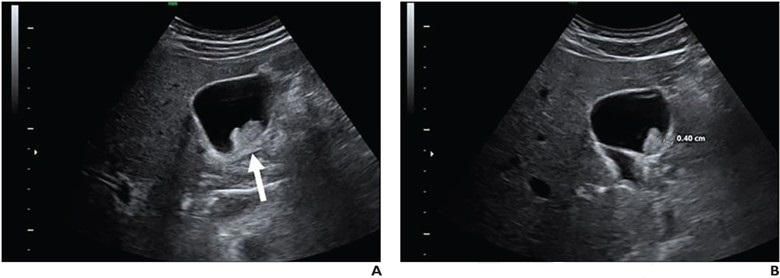
42-year-old man who presented with right upper quadrant pain. Transverse (A) and sagittal (B) greyscale ultrasound images of gallbladder show 25-mm nonmobile sessile polyp with adjacent wall thickening (arrow, A; calipers, B). Polyp was classified as extremely low risk by no readers, low risk by 4 readers, and indeterminate risk by 6 readers. Surgical consultation was recommended by all 10 readers. Pathologic assessment from cholecystectomy yielded adenoma, consistent with benign neoplastic polyp.
February 15, 2024 — According to the American Journal of Roentgenology (AJR), 10 abdominal radiologists showed substantial agreement for gallbladder polyp risk categorizations and surgical consultation recommendations, although areas of reader variability were identified.
“The findings support overall reproducibility of the Society of Radiologists in Ultrasound (SRU) recommendations,” wrote Mark A. Anderson, MD, from the department of radiology at Massachusetts General Hospital in Boston. “Nonetheless, efforts should seek to further improve the consistency of polyp risk categorization by radiologists.”
Anderson et al.’s AJR accepted manuscript included 105 patients (median age, 52 years; 75 women, 27 men) with a gallbladder polyp on ultrasound—without features highly suspicious for invasive or malignant tumor—who underwent cholecystectomy (January 1, 2003–January 1, 2021). Ten abdominal radiologists independently reviewed ultrasound examinations and, using SRU recommendations, assessed one polyp per patient for risk category (extremely low, low, indeterminate) and possible recommendation for surgical consultation. Interreader agreement was evaluated between five radiologists with less than 5 years of experience and five more experienced (≥ 5 years) radiologists. Polyps were classified pathologically, either neoplastic or nonneoplastic.
Ultimately, among 10 abdominal radiologists applying the SRU’s recommendations from 2022, interreader agreement for risk category assignments was substantial among all readers (k = 0.710), less-experienced readers (k = 0.705), and more-experienced readers (k = 0.692). Interreader agreement for surgical consultation recommendations was substantial among all readers (k = 0.795) and more-experienced readers (k = 0.740), and almost perfect among less-experienced readers (k = 0.811).
For more information: www.arrs.org


 December 05, 2025
December 05, 2025 









